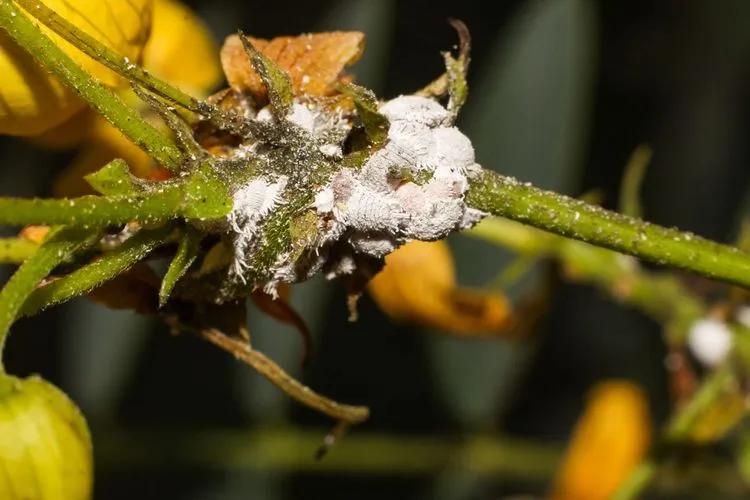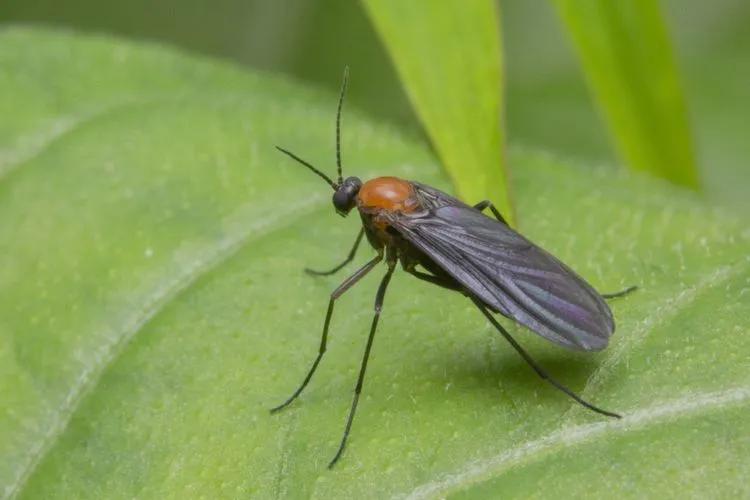It often happens that the lush greenery growing on the windowsill begins to wither and die. There are several options for how the plant could become infected.
- The plants were taken outside, on an open veranda or balcony during the warm season.
- You left windows or vents open for a long time.
- The flower was transplanted into a fresh substrate. Even store-bought soil is contaminated, all the more there is no guarantee of protection if the soil is taken from a forest or garden.
- Made mistakes in our daily care. They weaken a living organism, reduce its resistance, which will certainly be used by parasites.
You can’t protect your plants from all possible dangers; thus, you need to prepare to fight for your green pets.
Scales
 Outwardly, it resembles a brown or cream-colored growth on the stem. In fact, this is an insect hiding under a dense chitinous shell. Its dimensions do not exceed 4 mm. If you do not take any measures, the number of scale insects quickly increases, they stick around the stems, appear on the back of the leaves, and even on the fruits. The parasites stick to the plant and suck nutritious juices out of it. It turns yellow and gradually dries up.
Outwardly, it resembles a brown or cream-colored growth on the stem. In fact, this is an insect hiding under a dense chitinous shell. Its dimensions do not exceed 4 mm. If you do not take any measures, the number of scale insects quickly increases, they stick around the stems, appear on the back of the leaves, and even on the fruits. The parasites stick to the plant and suck nutritious juices out of it. It turns yellow and gradually dries up.
How to fight Collecting pests by hand, thoroughly cleaning all shoots with a soft brush, you can use a toothbrush. Rinsing under a sufficiently hot shower, but not more than 50 ° C. Thorough treatment with a strong soapy solution. For its preparation, laundry soap is taken.
Mealybug
 Grayish or cream-colored parasites are clearly visible against a green background. They huddle in small groups, secrete a pad that looks like cotton balls or honeydew. It is a sweet liquid that attracts fungus, which becomes an additional threat to the flower. The louse sticks to the shoots suck the juice out of them. The most dangerous type of worm is root. It settles underground, therefore it is invisible. You can see it only by removing an earthen lump from the pot. There is found a "family" of parasites powdered with flour, as it were.
Grayish or cream-colored parasites are clearly visible against a green background. They huddle in small groups, secrete a pad that looks like cotton balls or honeydew. It is a sweet liquid that attracts fungus, which becomes an additional threat to the flower. The louse sticks to the shoots suck the juice out of them. The most dangerous type of worm is root. It settles underground, therefore it is invisible. You can see it only by removing an earthen lump from the pot. There is found a "family" of parasites powdered with flour, as it were.
How to fight
- If a root worm is affected, a soil change will be required. The roots are rinsed in hot water at a temperature of about 50 ° C.
- Manual collection of parasites, followed by thorough rinsing of the greenery under the shower head.
- Treatment with a soap solution. Prepared from the calculation: a teaspoon of grated laundry soap per liter of water.
- Rubbing the affected areas with an alcohol solution. In order not to harm, a small fragment is processed for the sample. Not suitable for pubescent varieties.
Spider mites
 Individuals are very small, the size of the largest does not exceed 1 mm. Attention is drawn to small puncture points on leaf blades and a silvery cobweb entangling shoots, leaves, flowers. Gradually, the bush is completely wrapped in cobwebs in which parasites live. They suck the juices out of him, he withers and fades. The spider mite settles on any crops, but small roses, ficuses, lemons, and other citruses are especially susceptible to it.
Individuals are very small, the size of the largest does not exceed 1 mm. Attention is drawn to small puncture points on leaf blades and a silvery cobweb entangling shoots, leaves, flowers. Gradually, the bush is completely wrapped in cobwebs in which parasites live. They suck the juices out of him, he withers and fades. The spider mite settles on any crops, but small roses, ficuses, lemons, and other citruses are especially susceptible to it.
How to fight
- Remove the leaves most affected by the mite.
- Spray the bush with an infusion of Persian chamomile, hogweed, creeping tenacious, pyrethrum or basil. Dissolved tea tree oil works well.
Thrips
 Their bodies are small, oblong, and their color is different: from pale yellow to coal black. The length does not exceed 3 mm. Thrips are very fertile, adults are able to fly.
Thrips are omnivorous, but prefer beautifully flowering crops: hibiscus, violet, geranium. Delicate young leaves and shoots are especially vulnerable to them. Varieties with dense leaves are less interesting to insects. Under their attack, the bush is covered with small punctures, dots of a yellowish tint. Small black specks of excrement also become visible. Thrips settle on green aboveground parts and in a soil coma. You need to know this when starting to destroy the colony in order to process all the infected areas.
Their bodies are small, oblong, and their color is different: from pale yellow to coal black. The length does not exceed 3 mm. Thrips are very fertile, adults are able to fly.
Thrips are omnivorous, but prefer beautifully flowering crops: hibiscus, violet, geranium. Delicate young leaves and shoots are especially vulnerable to them. Varieties with dense leaves are less interesting to insects. Under their attack, the bush is covered with small punctures, dots of a yellowish tint. Small black specks of excrement also become visible. Thrips settle on green aboveground parts and in a soil coma. You need to know this when starting to destroy the colony in order to process all the infected areas.
How to fight
- The buds and flowers are removed, since the largest number of beetles accumulates here.
- In a small amount of water, a zoo shampoo against ticks, which contains permethrin, is diluted. Beat it into a dense foam. It is applied to the stems and leaves, left for 35-40 minutes, then washed off.
Sciarids
 The second name is mushroom mosquito. A signal of the appearance will be small black flies flying around the room. They are safe for plants, but they lay eggs, which develop into worm larvae. The latter feed on the juices of indoor greenery, clinging to its delicate roots. Therefore, with the sudden appearance of midges, it is necessary to immediately check whether sciarids have started in the soil. This is very easy to do. It is enough to remove a small layer of soil, the laying of larvae is usually located at a shallow depth.
The second name is mushroom mosquito. A signal of the appearance will be small black flies flying around the room. They are safe for plants, but they lay eggs, which develop into worm larvae. The latter feed on the juices of indoor greenery, clinging to its delicate roots. Therefore, with the sudden appearance of midges, it is necessary to immediately check whether sciarids have started in the soil. This is very easy to do. It is enough to remove a small layer of soil, the laying of larvae is usually located at a shallow depth.
How to fight
- The soil in the pot must be dried. Excess moisture attracts mushroom mosquitoes.
- The use of organic waste, such as peeling potatoes, shells, and tea leaves as a top dressing, is excluded.
Aphids
 Not more than 2 mm, translucent specimens. They form the backbone of the colony. A small part of it consists of winged aphids, which capture new areas for settlement. It is very easy to spot an invasion. Individuals stick to shoots or leaves, pierce their shell and suck out the juice. The puncture sites are visible as dark specks. In the course of life, aphids produce honeydew. It is a sweet liquid that sticks together the buds and clogs the stomata. Dew attracts ants, which use it for food.
Not more than 2 mm, translucent specimens. They form the backbone of the colony. A small part of it consists of winged aphids, which capture new areas for settlement. It is very easy to spot an invasion. Individuals stick to shoots or leaves, pierce their shell and suck out the juice. The puncture sites are visible as dark specks. In the course of life, aphids produce honeydew. It is a sweet liquid that sticks together the buds and clogs the stomata. Dew attracts ants, which use it for food.
How to fight Individuals do not hold well in place, they are carefully washed off under a shower stream. It is advisable to give a strong pressure, so the flushing will be more effective. Spray the bush with citrus infusion. For 1 liter of water, a few drops of essential oil or 4 tbsp. spoons of zest. Treat with soapy water. For 1 liter of water, a teaspoon of grated laundry soap.
